Mike Polito's Antarctic Blog 2009
Follow along with Mike as he travels to the Antarctic Peninsula to study penguins. Posts are in chronological order from the top.
___________________________________
Dec. 15th 2009 - On My Way South
I will be leaving soon for my research trip to the Antarctic Peninsula. To get there I must first fly from the USA to Santiago, Chile. Santiago is the capital city of Chile, and its largest city.
From Santiago I will then travel to Ushuaia, Argentina which is located at the southern tip of South America. Ushuaia is the capital of the Argentine province of Tierra del Fuego. It is also known as the southernmost city in the world. Check out this link to learn more about Ushuaia.
Along the way I will meet up with Bill Patterson from the University of Saskatchewan in Canada. Bill is an Co-investigator on our project whose specialty is in stable isotope analysis. Our research uses stable isotope analysis to estimate penguin diets by using the principle of "you are what you eat". By studying the isotopic composition of tissues such as eggshells and feathers we can learn what types of food (fish, squid, krill etc.) penguins eat when they are laying eggs and growing their feathers.
OK, that's it for now. Make sure you check back to learn more about our research and see pictures and videos from Antarctica. Students from Gregory Elementary School in Wilmington, NC can also look forward to answers to the questions you submitted to your teachers.
___________________________________
Dec. 16th 2009 - Santiago, Chile
I have arrived today in Santiago, Chile, the first stop on my way to Antarctica. Santiago is the capital city of Chile, and its largest city. Follow this link to learn more about Santiago, Chile.
I spent the day touring around the city and visiting the central plaza, cathedral, and presidential palace. It is the middle of the summer here and hot at about 90 degrees Fahrenheit! That's a big change in temperature from when I left Wilmington, NC (~50 degrees F). I have one more day in Santiago before Bill (our resident isotope expert) and I head south to Ushuaia, Argentina where we will get on the ship that will take us to the Antarctic Peninsula.
___________________________________
Dec. 17th 2009 - Santiago, Chile
I am in Santiago for one more day before heading south to Ushuaia, Argentina and then Antarctica. Therefore I thought it might be a good time to answer one of the questions I received from students at Gregory Elementary School in Wilmington, NC.
This question is from Divia in Ms. Trutt’s second grade class: How did you first learn about penguins?
I first learned about penguins when I was about 6 years old. One of my favorite things to do at this age was to read a magazine called Zoobooks. This magazine is about all the different types of animals in the world. You might have heard of it as it is still around (click on this link to see the Zoobooks’ penguin issue).
Also when I was this age my family visited SeaWorld and I was able to see some of the species of penguins I had read about. Visiting zoo’s and aquariums made me interested in learning more about animals. However, at that time I did not know that one day I would be working in Antarctica studying penguins. Check back again for more answers to your questions!
___________________________________
Dec. 18th 2009 -Ushuaia, Argentina
Today I made it to Ushuaia, Argentina which is located at the southern tip of South America. Ushuaia is commonly called the southernmost city in the world. Check out this link to learn more about Ushuaia.
I came to Ushuaia to get on board the ship that will take me to Antarctica. This ship is named the "National Geographic Explorer" and is ship that carries both tourists as well as Antarctic scientists like myself. This ship travels all over the Antarctic Peninsula so it is a great way to visit many penguins colonies and learn what types of food the penguins from all these places are eating.
From here on, my access to the internet may be a bit spotty, but I will try to post updates when I can!
___________________________________
Dec. 19th 2009 - At Sea: Drake's Passage
The ship set sail last night and now we are at sea on the our way south to the Antarctic Peninsula. It will take a little over one full day at sea before we reach land. We are crossing a part of the Southern Ocean between the tip of South America and Antarctica called Drake's Passage. The "Drake" is known for high winds, big waves and rough seas but we have been lucky with a calm and sunny crossing. Click hear to learn more about the Drake's Passage and the Southern Ocean.
Sometime tomorrow we should make our first landing on a group of islands in Antarctica called the South Shetland Islands. This will be my first chance this season to study the penguins that we find there!
___________________________________
Dec. 20th 2009 – Deception Island, South Shetlands, Antarctica
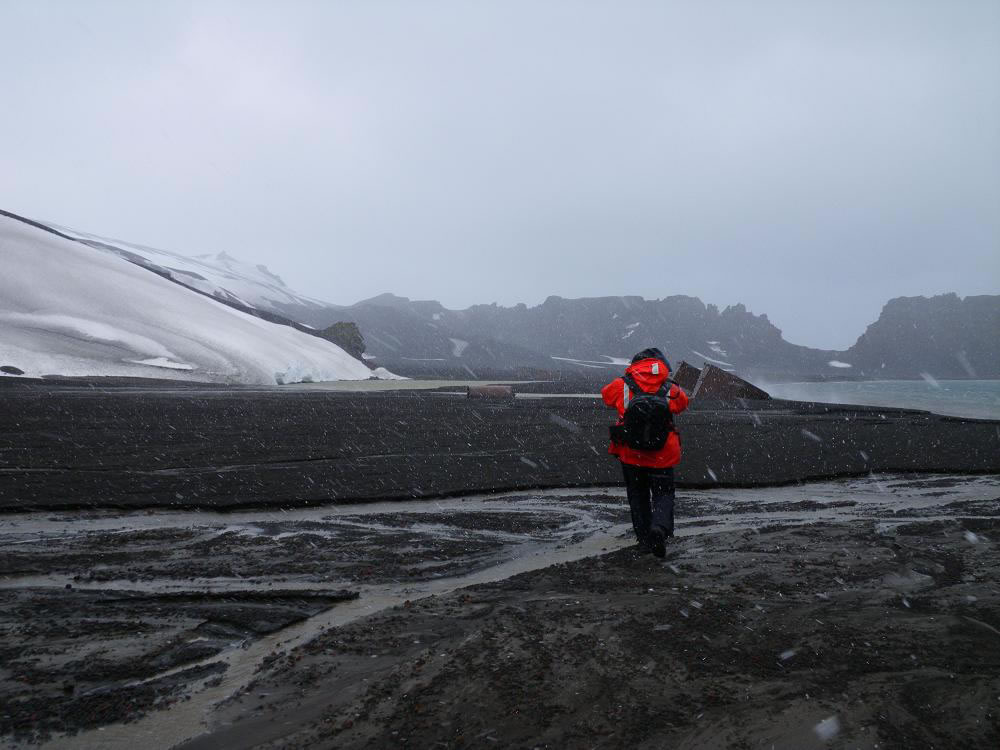
Our first stop in Antarctica is Deception Island, on South Shetland Island found along the Northwestern tip on the Antarctic Peninsula. We landed in a protected harbor called Whaler’s Bay which, while there are no penguin colonies, this location was the site of an old commercial whaling station. During the first half of the last century this location was where large whales which were caught by whaling ships were processed to make oil and other whale derived products. During this time the populations of Antarctic whales decreased severely and most have still not recovered fully today.
Just like penguins, whales eat krill which are tiny shrimp-like animal. When people killed many of the whales in Antarctica 100 to 200 years ago it led to an abundance of krill for other animals in Antarctica. That is, when people removed the whales from the Antarctic ecosystem by hunting them, whales were no longer there to eat krill, so much of the krill that whales would have eaten was then likely available to penguins and other krill eating animals. Research by Dr. Emslie using stable isotopes found that penguins shifted their diets from fish to krill during the time that whales were being hunted, which has helped to confirm the above theory.
OK, That’s it for now. I don’t know where we will go tomorrow. Hopefully it will be a penguin colony!
___________________________________
Dec. 21th 2009 – Penguin Point, Seymour Island, Antarctica

Penguins at last! Today we were dropped off at Penguin Point on Seymour Island which is on the Northeast side of the Antarctic Peninsula. Penguin Point is the location of a colony of Adélie penguins. Adélie penguins are one of the three Brush-tail penguins that we study for the UNCW Penguin’s Past & Present Project. They are found all around Antarctica and have black feathers on their back and head and white feathers on their fronts.
It is time to answer another question from students at Gregory Elementary School in Wilmington, NC. Gianna from Ms. Trutt’s second grade class asks: “Why did penguins loose the ability to fly? Gianna is correct as that all the modern species of penguins, like the Adélie penguins at Penguin Point can not fly. Instead, they are especially adapted to swim under the water using their wings at paddles to help propel and steer them while swimming.
The ancestors of the modern penguin species were birds that did have the ability to fly. These birds likely lived near the ocean or inland seas and feed on fish and other marine animals similar to modern penguins. These “penguin ancestors” gradually lost their ability to fly as they evolved special adaptations which helped them swim faster and deeper to allow them to more easily to live and catch food in the ocean. Eventually the early penguin species evolve to become so adapted for swimming that they did not need to and could no longer fly.
___________________________________
Dec. 22th 2009 – Paulet Island, Antarctica
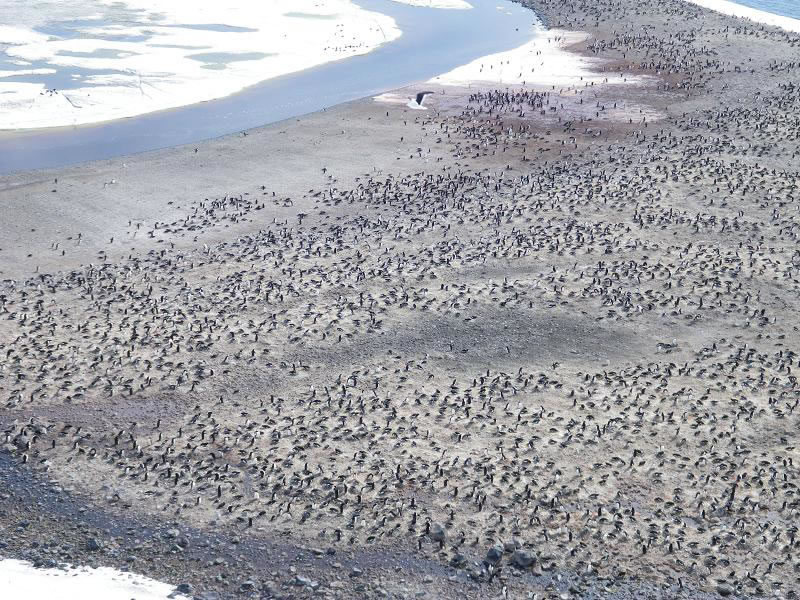
Today we stopped at Paulet Island. It is the location of a very large Adélie penguin colony. As you can see from the picture above, there are many penguin thousands of penguins breeding on this island. You might ask: how many penguins are there on Paulet Island? Well, researchers like those from Oceanites, a non-profit Antarctic research and conservation group, have developed methods to help count penguin colonies to better understand changes in penguin populations. In general, researches don’t count individual penguins, but instead count penguin nests. Nest are much easy to count be cause they don’t move around like penguins and we know that for every nest there is one breeding male and one breeding female. It is the number of breeding pairs that is important to biologist as these are the animals that are reproducing and helping to maintain the overall population. Based on nest counts from photographs like the on above, researchers have estimated that there are more than 100,000 breeding pairs of Adélie penguins on Paulet Island.
Follow this link for a video of me talking about Adélie penguins and Brown Skuas on Paulet Island.
___________________________________
Dec. 23rd 2009 – Cuverville Island, Antarctica

Today I visited a colony of Gentoo penguins at Cuverville Island. Gentoo penguins are another of the three Brush-tail penguins that we study for the UNCW Penguin’s Past & Present Project. They are slightly larger in size than Adélie penguins and have orange-red beaks and white patches of feathers over their eyes. Similar to the other Brush-tailed penguins, gentoo penguins breed on land during the Antarctic summer (from about October to March). They lay there eggs in nests that they make out of pebbles. Gentoo penguins spend a lot of time building their nests and build the tallest and largest pebble nests of any of the three species of Brush-tailed penguins.
Why do Gentoo penguins build their nests out of pebbles? Well as you can see from the picture above, snow that has accumulated during the winter often will melt during the summer when the penguins are nesting. Big, tall nests made out of pebbles help to keep the gentoo penguin’s eggs high and dry even when their breeding colony gets flooded by snow melt. Building pebbles nests help to keep a penguin’s eggs warm and safe from harm until the chicks hatch later in the breeding season.
Check out this short video about Gentoo penguins from when I visited a colony at Petermann Island.
___________________________________
Dec. 24th 2009- Below the Antarctic Circle: Detaille Island, Antarctica
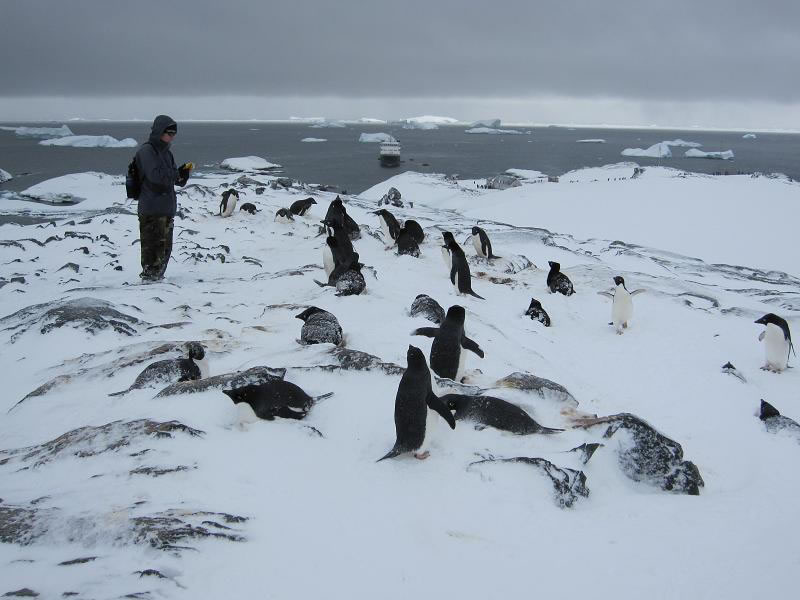
It’s Christmas Eve and we are at Detaille Island . This island is the site of a former British research hut. The hut was used to study geology and meteorology from 1956 to 1959 and then was abandoned due to its isolation from other stations. In addition to the hut, this island also has a small colony of Adélie penguins. At this colony we collected eggshells from recently hatched chick which will allow us to discover what types of food that the female penguins were eating prior to laying their eggs. It was a cold an snowy day, but as the wind was calm we were able to travel by zodiac (a small rubber boat) to another nearby colony of Adélie Penguins. We stayed out in the cold weather for over 6 hours counting the penguins and collecting eggshells for isotopic analysis. Afterwards we went back aboard the ship and we traveled even farther to 67˚ 09’ south until we turned north to as the ice would not allow us to travel any farther south.
___________________________________
Dec. 25th 2009 - Merry Christmas: Yalour Islands , Antarctica
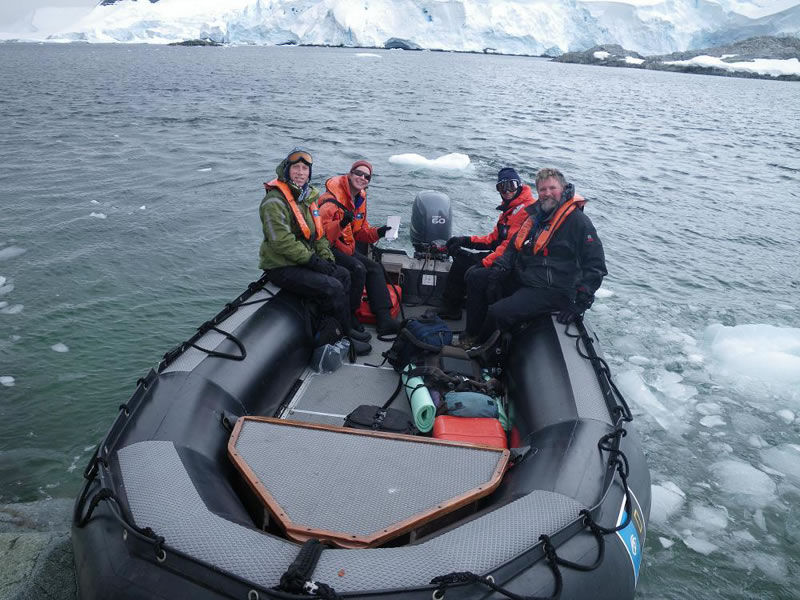
Merry Christmas! Today was an adventurous Christmas Day in Antarctica . We spent the morning using the small rubber boats called Zodiacs to travel among the many small islets that make up the Yalour Islands . With the help of Ben, the Chief Mate of the National Geographic Explorer, we (myself, Bill Patterson and Iris Saxer who is a penguin researcher from Oceanites) were taxied around from island to island. At each island we hopped off to count the Adélie penguins and Blue Eyed-shags that are breeding on these islands and collect recently hatched eggshells for dietary analysis.
Zodiacs are a very important tool for researchers in the Antarctic Peninsula . There are no ports, docks or piers for ships in Antarctica so we used these rubber boats to travel from the ship we are traveling on to the beaches near the penguin colonies we visit. Luckily for us, the staff and officers of the National Geographic Explorer are the most skilled and safest Zodiac drivers I have ever seen in Antarctica . Without their support we would not be able to visit the many penguin colonies we go to for our research project.
___________________________________
Dec. 26th 2009 – Spigot Peak , Antarctic Peninsula

Today we finally visited a breeding colony of Chinstrap penguins! These are the smallest of the three species of Brush-tailed penguins and they get their name from the small black line of feathers found underneath their beak that look like the chinstrap of a helmet. They are also one of the loudest penguins and colony of Chinstrap penguins is full of raucous ear-splitting calls. Their loud vocalization and calls earned them the nickname of “Stone-cracker penguins” by early Antarctic explorers.
Bill, Iris and I spent much of our time at Spigot Peak counting and mapping the location of the Chinstrap penguin nests. Chinstrap penguins often nest along steep slopes and on the sides of windswept ridge lines high above the water. They nest in these areas because they are free of snow earlier in the Antarctic spring and nests in these locations will not get buried in snow during summer storms. However, for us means that we had to hike up a steep snowy slope to climb up to where the Chinstrap penguins were nesting. It was worth it as the view from these heights was spectacular.
___________________________________
Dec. 27th 2009 – At Sea: Student Volunteers Lend a Hand!
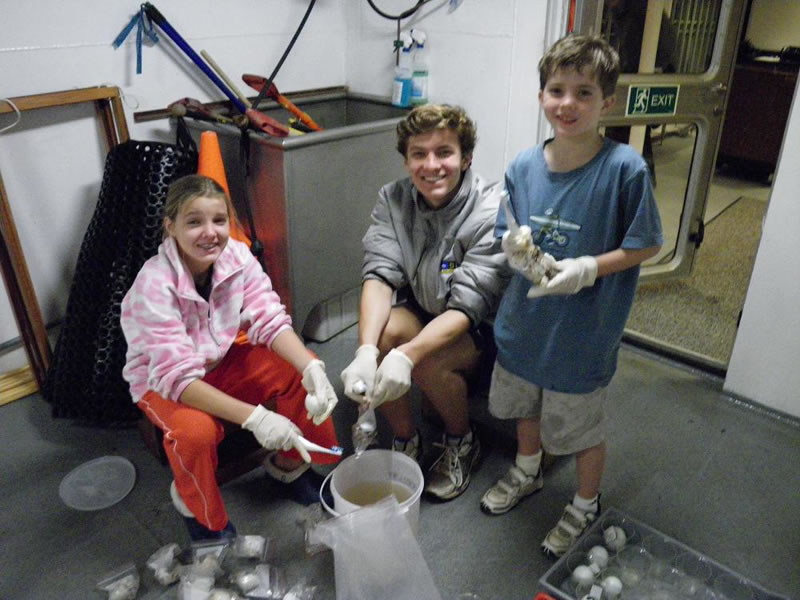
We are now back at sea, heading north for Ushuaia, Argentina. We spent the time at sea entering all the information we collected about the penguins into our computer for safe keeping. The time at sea also gave us a chance to catch up on a little rest after a busy week in Antarctica . We visited about 12 penguin colonies this last trip and worked very hard to count nests, map their breeding colonies and collect hatched eggshells for dietary analysis.
We also spent today getting all of the eggshell samples we collected ready to be sent back to UNCW so that we can analyze them. Lucky for us we had some young students on board the ship that volunteered their time to assist with this job. They helped us make labels for each sample so that we know where and when samples were collected. In addition they helped to clean the eggshell samples of dirt and penguin guano and dry them before bagging them in individually labeled bags. It was a messy job, but everyone seemed to have a great time! We want to thank the young budding scientist that helped out with this dirty but important job: Carson Crane, Christopher Crane, David Crane, Isabella Crane, Charlie Dennis, Lauren Liedel, Taylor Lipman, Sophie Hersh, Tyler Sanders, Carley Walters and Cole Walters.
It’s time once again for a question from the students at Gregory Elementary School in Wilmington, NC . Evan from Ms. Trutt’s Second grade class asked: What tools do you use for researching penguins?
While in the Antarctica Peninsula we use very simple tools to collect information and eggshell samples from the penguins we study. We use small hand-held “clickers” to help us count the penguin nests and keep track of how many there are. We have notebooks with waterproof paper were we right down the information we collect. We collect eggshell samples and clean them with a toothbrush to remove dirt and penguin guano before placing them in zip-top plastic bags and sending them back to UNCW. At UNCW we use a complicated machine called a “Isotope Ratio Mass Spectrometer” to analyze the eggshell samples. This machine allows us to examine the isotopic signature of the eggshells so that we can determine how much fish and krill penguins were eating prior to laying their eggs.
___________________________________
Dec. 28th 2009 – Back in Ushuaia, Argentina
We are now back in port at Ushuaia, Argentina after a fun and exciting trip to the Antarctic Peninsula. Tomorrow we we will re-supply the ship, pick up new guests and staff and then return to Antarctica. Then after 11 more days in Antarctica I will return to Ushuaia and then fly back home to Wilmington, North Carolina.
Due to issues with the internet connection on board the ship I will not be blogging during this next trip. However, make sure you check back with this blog as when I get back I will be adding more pictures and videos of my time in Antarctica. Also don't forget that Dr. Emslie will be in Antarctica starting January 7th 2010 so please check out his blog page as well (follow this link).
I hope that you have enjoyed learning about our research and how we live and work in Antarctica. Thank you most of all to the students from Gregory Elementary School in Wilmington, NC for the questions that you submitted!

.jpg)

